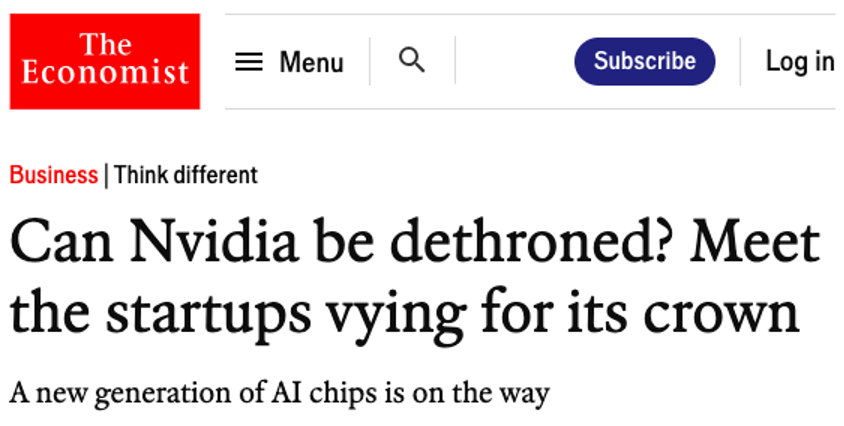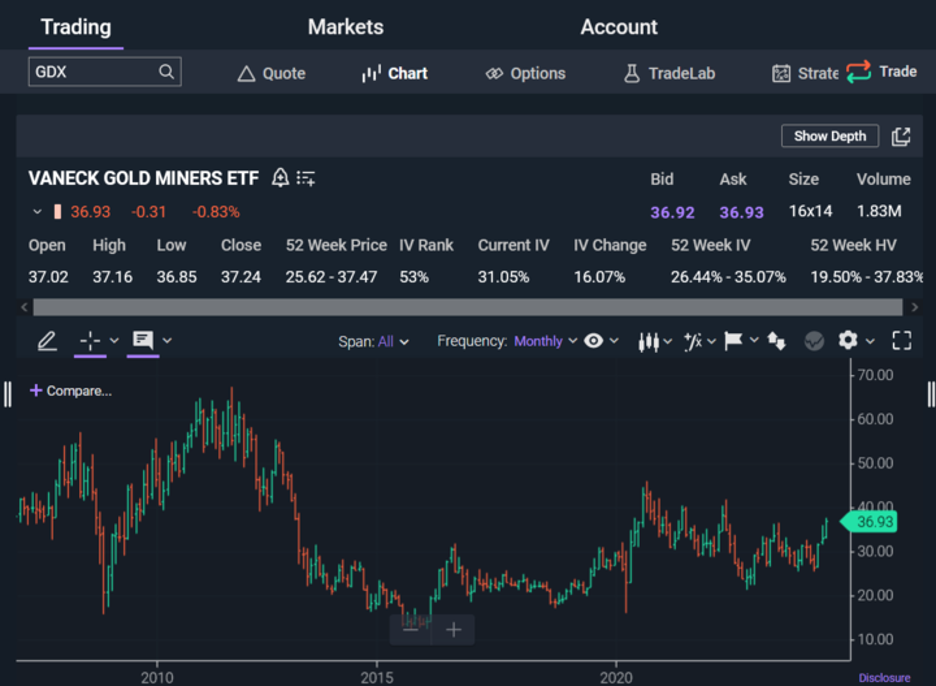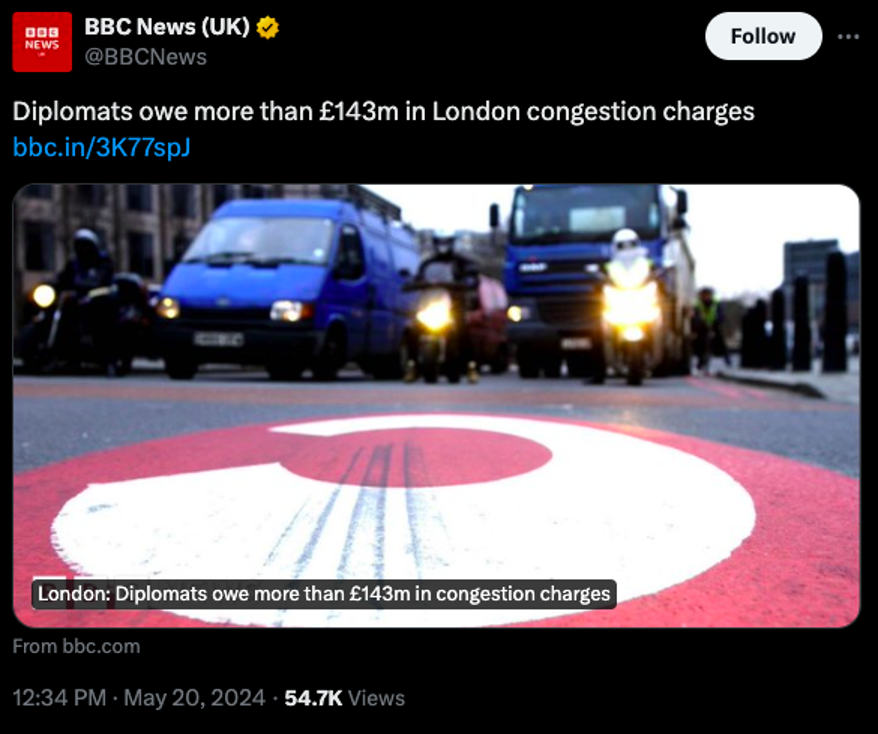NVDA: Noise vs. News
![]() NVDA: The Noise vs. the News
NVDA: The Noise vs. the News
 Across nearly 40 years of covering news and markets, I’m hard pressed to recall a time when one company generated as much sustained buzz as Nvidia does now.
Across nearly 40 years of covering news and markets, I’m hard pressed to recall a time when one company generated as much sustained buzz as Nvidia does now.
Maybe Apple in the years after the iPod’s introduction in 2001. As we’ve mentioned now and then, including yesterday, Nvidia CEO Jensen Huang’s dog-and-pony shows are reminiscent of the presentations by Steve Jobs back in the day.
But Jobs was hawking uniquely sexy and useful consumer products. Huang is hawking… semiconductors used in datacenter servers that you and I will never see.
No matter. With widespread interest in AI and with NVDA set to report its quarterly numbers just hours from now, no Nvidia headline is too small to escape notice — or move the share price. NVDA shares wobbled yesterday when this headline dropped…

An earth-shaking development? As the trading-minded editors at Paradigm will remind you, it’s not the news that matters, it’s the reaction. NVDA ended the day up two-thirds of a percent from the day before — an all-time high.
[This just in: “Amazon.com's cloud services unit said on Tuesday that it has not halted any orders of Nvidia's most advanced chip on the market, but has instead decided to purchase the company's newer state-of-the-art chip for an upcoming supercomputer project between the companies,” Reuters reports. The FT amended its story.]
 Meanwhile, because the media are so predictable, stories abound about “the next Nvidia.”
Meanwhile, because the media are so predictable, stories abound about “the next Nvidia.”

The gist of this story in The Economist is that while Nvidia’s chips are desirable for AI applications, they weren’t designed for AI applications. They were designed for heavy-duty computer graphics and video.
“Might it be better to design specialist AI chips from scratch?” the story asks. “That is what many companies, small and large, are now doing in a bid to topple Nvidia.”
Interesting, to be sure. But not exactly useful if you’re a retail investor trying to figure out the best way to ride the AI wave right now. By and large, these companies are startups, not yet publicly traded. Unless you have deep pockets and the right connections, you’re out of luck.
Besides, not all of those startups are guaranteed survivors in a highly competitive space. Some of them will surely go to zero.
For now, the best risk-reward proposition in AI comes from companies that are riding Nvidia’s coattails — especially if they’re not trading at nosebleed levels. (Unlike, umm… Nvidia itself.)
As it happens, Paradigm’s own AI authority and venture-capital veteran James Altucher says one tiny company is responsible for the placement of Nvidia’s next-gen chips.
If you’re already hip to James’ AI “Wealth Window” thesis… he says this company will accelerate the wealth window, seeing 100x growth by next year.
You might want to click here and check out his presentation right away — just in case Jensen Huang drops this company’s name during NVDA’s conference call later this afternoon.
![]() Finally, Good News for Gold Stocks
Finally, Good News for Gold Stocks
 “Hey, hey — GDX breakout of 15-year trend,” says an e-chat message from Alan Knuckman, our eyes and ears at the Chicago options exchanges.
“Hey, hey — GDX breakout of 15-year trend,” says an e-chat message from Alan Knuckman, our eyes and ears at the Chicago options exchanges.
Plain-English translation: Gold stocks are finally getting traction.
Of course, gold itself has been trading near all-time highs. And silver is trading at its highest levels in over a decade. But gold stocks have been stuck in the mud, the GDX ETF near $37. Pathetic — it traded for $43 in 2020!
But feast your eyes on this screenshot Alan sent…

Take a look at GDX’s blowoff top in 2011. Then look at the bottom it put in during late 2015-early 2016. As of yesterday, GDX has recovered half of that drop.
That’s an unquestionably bullish development. New all-time highs are on the way.
Maybe not instantly — but eventually. Act accordingly.
 U.S. existing home sales surprisingly dropped for the second month in a row.
U.S. existing home sales surprisingly dropped for the second month in a row.
According to the National Association of Realtors, April contract closings fell 1.9% from March. Meanwhile, the supply of homes for sale increased more than 16% in April year-over-year.
“Home prices reaching a record high for the month of April” — $407,600 — “is very good news for homeowners,” says NAR Chief Economist Lawrence Yunt. “However, the pace of price increases should taper off since more housing inventory is becoming available,” he says.
Of the three major U.S. stock indexes today, the tech-heavy Nasdaq is the only one in the green: up 0.10% to 16,850. Like a reverse mirror image, the DJIA is down 0.10% to 39,825. And the S&P 500 is sandwiched between the two, basically flat at 5,320.
When it comes to commodities, it’s pretty much red all over. Crude is down 0.55% to $78.20 for a barrel of West Texas Intermediate. Meanwhile, gold and silver are getting hammered. Gold’s lost $30.50 per ounce to $2,395, and silver’s down 1.60% to $31.55.
Of course, Nvidia’s earnings report comes after the market’s close this afternoon. Also today, the Fed’s latest policy-meeting minutes are scheduled for release. More on both tomorrow…
![]() Economic Warfare: Two Can Play That Game
Economic Warfare: Two Can Play That Game
 Now that the Biden administration is moving to confiscate some of Russia’s U.S. Treasuries, Moscow is moving to retaliate.
Now that the Biden administration is moving to confiscate some of Russia’s U.S. Treasuries, Moscow is moving to retaliate.
A court in St. Petersburg has seized nearly $760 million in assets belonging to three European banking giants — Italy’s UniCredit, and Germany’s Deutsche Bank and Commerzbank.
“The seizure is one of the biggest moves against Western lenders since Moscow’s invasion of Ukraine prompted most international lenders to withdraw or wind down their businesses in Russia,” says the Financial Times.
Hypothetically, this seizure is unrelated to the “REPO Act” passed by Congress and signed by Joe Biden last month, authorizing the seizure of about $6 billion in Treasuries owned by the Central Bank of Russia and held within the United States. Rather, it has to do with a complicated dispute between the banks and a subsidiary of the Russian natural gas giant Gazprom.
But the subtext is unmistakable: Most of Russia’s Treasuries — nearly $300 billion worth — are held within European institutions. Confiscating those assets will require the cooperation of European leaders.
This matter is sure to come under discussion at the next G7 summit in Italy in mid-June. Moscow is sending a not-so-subtle signal about the potential consequences.
Paradigm macro maven Jim Rickards elaborated recently to his Strategic Intelligence readers: “If Europe joins the U.S. in stealing Russian assets, Russia will retaliate by seizing billions of dollars of direct foreign investment in Russia owned by major European companies such as Siemens, Total, BP and others.
“The value of the European assets subject to seizure by Russia is greater than the value of the U.S. Treasuries owned by Russia.
“It could be the case that Russia makes a net profit from the two-way confiscation. Nice job, Joe Biden.”
Let’s not let Congress off the hook for this potential debacle– 316 members of the House and 70 senators are also culpable.
![]() The Fix Is In
The Fix Is In
 The head of the FDIC is resigning under a cloud. The CEOs of the big banks are breaking out the Champagne.
The head of the FDIC is resigning under a cloud. The CEOs of the big banks are breaking out the Champagne.
On Monday night, news broke that FDIC chair Martin Gruenberg would resign as soon as Joe Biden names a successor and that successor is confirmed in the Senate.
Gruenberg’s decision comes after what CNN describes as “a scathing independent investigation detailing pervasive sexual harassment, discrimination and bullying at the agency.”
The pressure had been building for months, ever since a series of articles in The Wall Street Journal last November describing a toxic work culture at the FDIC.
The timing of the scandal’s emergence was incredibly convenient for the major banks. As Pam Martens and Russ Martens wrote earlier this month at their Wall Street on Parade site…
Gruenberg held the deciding vote at the FDIC last July when the bank regulator approved moving forward with proposed new rules to significantly raise the capital levels at the megabanks on Wall Street, particularly those holding trillions of dollars in derivatives off their balance sheet.
 Those would be the same megabanks that got enormous bailouts during the financial crisis in 2008… and again during the “repo” crisis of 2019 and during COVID in 2020… because they didn’t have enough capital on hand to withstand those crises. These rules were aimed at preventing a repeat episode.
Those would be the same megabanks that got enormous bailouts during the financial crisis in 2008… and again during the “repo” crisis of 2019 and during COVID in 2020… because they didn’t have enough capital on hand to withstand those crises. These rules were aimed at preventing a repeat episode.
The FDIC did not have the last word on the rules, though. The Federal Reserve and the Office of the Comptroller of the Currency also had a say.
The banksters circled the wagons, using their clout at the Fed in hopes of getting the FDIC to back off. Meanwhile, Republicans in Congress who oppose the rules demanded Democrat Gruenberg’s resignation — even though he personally was never accused of sexual harassment.
On Monday, a front-page story in The Wall Street Journal reported that the pressure campaign is likely to pay off: “The Fed and two other federal regulators are moving toward a plan that would significantly lessen a nearly 20% mandated increase in capital for the biggest U.S. banks, according to people familiar with the matter.”
But just to make sure the deal was sealed, a top Democrat on Capitol Hill turned on Gruenberg hours later and demanded his resignation. And not just any Democrat — Sen. Sherrod Brown (D-Ohio), the chair of the Senate Banking Committee.
 Just sordid, sordid stuff. And there are added details that make the story even more outrageous.
Just sordid, sordid stuff. And there are added details that make the story even more outrageous.
- The “independent” investigation into the work culture at the FDIC? It was conducted by the law firm Cleary Gottlieb — which counts among its clients most of the major banks. That is, the banks that wanted Gruenberg gone
- Brown is up for reelection this year. And as the Martenses report, his campaign war chest is “being fattened by Wall Street’s go-to Big Law firms” — including none other than Cleary Gottlieb
- The Journal article says JPMorgan Chase CEO Jamie Dimon led the charge to water down the regulations. That would be the same Jamie Dimon whose bank was accused by the government of the U.S. Virgin Islands of “actively participating” in the late financier Jeffrey Epstein’s sex trafficking.
Whenever the next phase of the bank crisis blows up — and it will, as we said again last month — you’ll know who shoulders some of the blame now.
![]() Deadbeat Diplomats
Deadbeat Diplomats
 Great moments in diplomacy…
Great moments in diplomacy…

As perhaps you’re aware, cars entering central London must fork over a congestion fee. It’s 15 pounds a day (about $19), required between 7:00 a.m.-6:00 p.m. on weekdays and noon-6:00 p.m. on weekends.
Recently, Transport for London — the body overseeing the collection of this tax — asserted that diplomats owe nearly $182 million in unpaid fees. Of this total, the American diplomats owe the most — $18.6 million. The rest of the top five are Japan, India, Nigeria and China.
But the American Embassy believes itself exempt: "In accordance with international law as reflected in the 1961 Vienna Convention on Diplomatic Relations,” says an embassy flack, “our position is that the congestion charge is a tax from which diplomatic missions are exempt.”
Transport for London is unimpressed with this logic. "We and the U.K. government are clear that the congestion charge is a charge for a service and not a tax.”
What’s more, “We will continue to pursue all unpaid congestion charge fees and related penalty charge notices, and are pushing for the matter to be taken up at the International Court of Justice."
I’d really like to see this. I’d get a charge out of seeing Secretary of State Antony Blinken being called to appear in The Hague. Of course, he’d ignore the summons.
Maybe then even British politicos would come to realize that in the “rules-based international order,” it’s Washington that makes the rules — and can change them at any time to suit its purposes. The Russians and the Chinese figured that out long ago…
See, there I go. I take a funky little story about a toll dispute and turn it into a reflection on the decline of the American empire — and by extension, the decline of the dollar as the globe’s reserve currency. Sign of the times, I guess…
Best regards,

Dave Gonigam
Managing editor, Paradigm Pressroom's 5 Bullets










